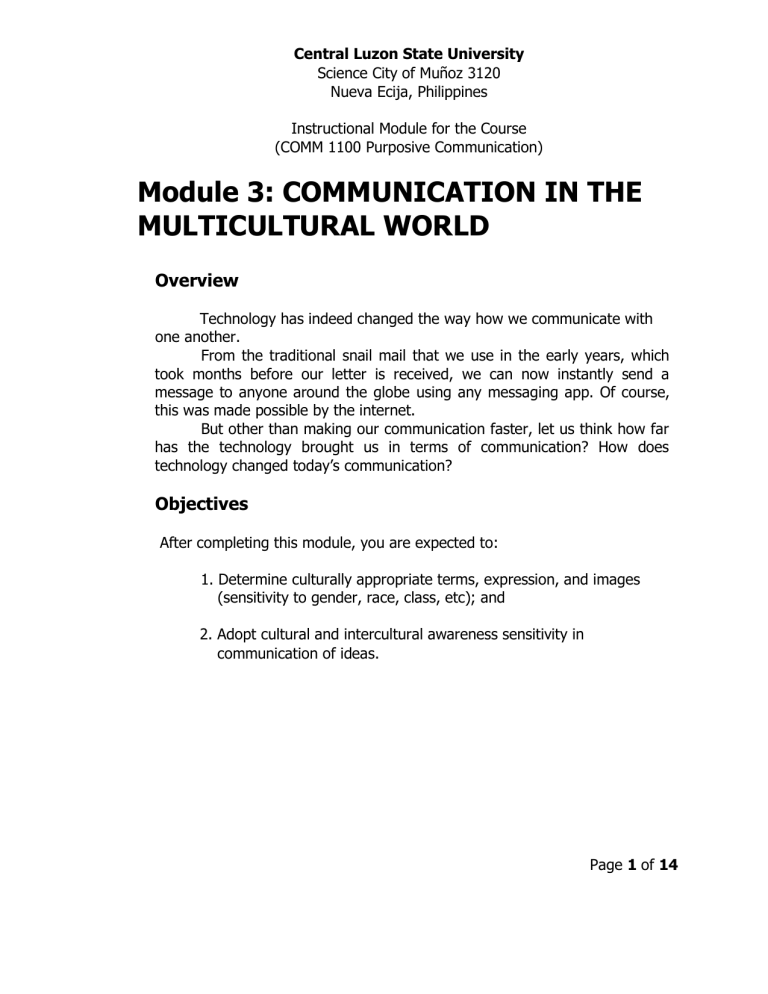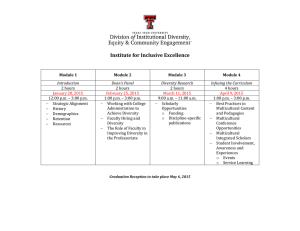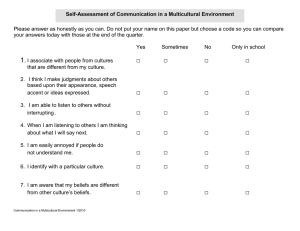
Central Luzon State University Science City of Muñoz 3120 Nueva Ecija, Philippines Instructional Module for the Course (COMM 1100 Purposive Communication) Module 3: COMMUNICATION IN THE MULTICULTURAL WORLD Overview Technology has indeed changed the way how we communicate with one another. From the traditional snail mail that we use in the early years, which took months before our letter is received, we can now instantly send a message to anyone around the globe using any messaging app. Of course, this was made possible by the internet. But other than making our communication faster, let us think how far has the technology brought us in terms of communication? How does technology changed today’s communication? Objectives After completing this module, you are expected to: 1. Determine culturally appropriate terms, expression, and images (sensitivity to gender, race, class, etc); and 2. Adopt cultural and intercultural awareness sensitivity in communication of ideas. Page 1 of 14 COMM 1100 (Purposive Communication) Topic 1 Local and Global Communication in multicultural settings Each society has a culture different from one another. Thus, the values, beliefs, attitudes, morals, norms, customs and practices embedded to us by our culture may be entirely different from others, if not, partially. The Philippines is a multicultural society. Despite our common identity as Filipinos, our culture is not uniform as we belong to different ethnic groups. Even families or clans have their own set of culture. The same goes to other countries, be it Asian or Western. Thus, the world we are living is indeed multicultural. This topic will teach you how to communicate in a multicultural setting, both in the local or global context. This will be useful in your professional journey in the future and will somehow help you adapt from working in a multicultural environment. Before jumping to our main topic, let us first understand what cross cultural, intercultural and multicultural communication is all about. Cross Cultural, Intercultural And Multicultural Communication: An Introduction Culture is the complex whole which includes knowledge, belief, art, morals, law, customs and habits and any capabilities acquired by man as a member of society (Taylor, 1871). It is also defined as the customary beliefs, social forms and material traits of a racial, religious or social group, or the set of shared attitudes, values, goals and practices that characterizes institution or organization (Merriam Webster Dictionary). Co-Cultures are composed of members of the same general culture who differ in some ethnic or sociological way from the parent culture. Examples Philippines – Igorots, Ilocanos, Bicolanos (Luzon) United States- Native Americans, certain Scandinavian American groups, Middle Eastern Americans, some Latino groups (especially those of Chilean, Peruvian, and Spanish ancestry), and some Asian American groups (Chinese Americans and Taiwanese Americans). Disabled, gays and lesbians, cyberfunks, elderly Page 2 of 14 COMM 1100 (Purposive Communication) Culture is the lens through which we see the world. Thus, as individuals, we have the tendency to see one’s own culture as superior to all. This is called ethnocentrism. Cultural relativism on other hand is the concept that accepts other cultural groups as equal in value to one’s own. It tries to understand the behavior of other groups. Cross Cultural Communication is the communication between people who have differences in any one of the following: styles of working, age, nationality, ethnicity, race, gender, sexual orientation, etc. It is how people belonging to different cultures communicate with each other. Importance of Cross Cultural Communication ❖ Globalization ❖ Business opportunities ❖ Job opportunities ❖ Sharing of views and ideas ❖ Talent improvisation ❖ An understanding of diverse market Intercultural Communication is the sending and receiving of messages across languages and cultures. It is also a negotiated understanding of meaning in human experiences across social systems and societies. When we talk of other cultures, we mean not only those who speak a language that is different from ours who live in a different country or region; we also mean those who live in the same city or region but who do not share the same social groups. Example A 14-year old teenager does not typically communicate the same way as an 82-year old senior citizen. Even if they were born and raised in the same neighborhood, their conversation could be just as “intercultural” as two people who come from opposite corners of the globe because they are from two subcultures*. *Subculture is a smaller group within a larger culture that shares language or behavioral patterns that are different from the larger group. Multicultural Communication is when people from multiple backgrounds, with different ways of communication, coexist without really interacting deeply—that’s a multicultural communication situation. Page 3 of 14 COMM 1100 (Purposive Communication) Local and Global Communication in multicultural settings Local communication is being able to communicate (verbal and non-verbally) with the members of your local area/community. Now, maybe you are asking yourself how one can communicate locally in a multicultural context? First, always bear in your mind that we do not only communicate thru words. Non-verbal communication (gestures and tone of our voice) is as important as verbal communication especially when you are engaging into a conversation with people different from your culture. In doing that, you should always observe cultural sensitivity. Cultural awareness is also a must in order to have a successful communication in this context. Cultural awareness is making proper responses to behaviors and norms exhibited by people from outside of one’s own culture. It is the foundation of communication and it involves the ability of standing back from ourselves and becoming aware of our cultural values, beliefs, and perceptions. Cultural awareness becomes essential when we have to interact with people from other cultures. People see, interpret and evaluate things in different ways. What is considered a right way of doing things in a culture is not usual in another one, and vice versa. Cultural Sensitivity Awareness If we don’t have cultural sensitivity awareness we misinterpret and misunderstand other people’s different deed. A misinterpretation comes when we lack awareness of our own behavioral rules and project them on others. Becoming aware of our cultural dynamics is difficult task because culture is not conscious to us. Our experiences, our values and our culture background lead us to see and do things in certain way. We have to step up from our cultural boundaries and put ourselves in multicultural environment in order to see different cultures perspective and different ways of perceiving things. Tips Towards A Successful Multicultural Communication 1. Keep an open mind. This may sound obvious, but keeping an open mind is the most important thing you can do in relating to people of different cultures. People simply don't do things the same way. If, of course, someone's differences are destroying the work flow and group culture, that is another matter. When that isn't happening, an open mind is critical. Page 4 of 14 COMM 1100 (Purposive Communication) Keeping an open mind means, in part, not stereotyping. We are bombarded with cultural assumptions every day, particularly in the media, and being an effective communicator means letting go of our own preconceived notions about our team members and the backgrounds they come from. 2. Have at least some knowledge of people's cultural backgrounds. To be fluid and cohesive with your team, it is important to have at least a general understanding of each member's cultural background. This will give you valuable cues as to how your team members approach people, their definitions of respect, their boundaries and their overall sense of how human interactions should be conducted. An encyclopedic knowledge is not required. Indeed, to assemble that much information on people would take time you could be devoting to other things. It is more practical to arm yourself with some basics, especially if you know you will be working in or around other cultures, such as traveling for business. For example, in Japan it is considered rude to show someone the sole of your shoe; many Jews and Muslims do not eat pork. Again, having this knowledge is a matter of awareness. The more cognizant you are of your team members' backgrounds, the better you will relate to them and the more effective your organization will be. 3. Practice active listening. All human beings feel more comfortable, more valued, and more a part of a team if they are confident they are being heard. Give people in your organization this value by actively listening to them: make eye contact with them (or not, depending on the culture); nod and give verbal indications you are listening. You may also find it helpful to summarize and restate what someone has told you, particularly if this restatement echoes a great idea or a concern. Active listening is an entire course unto itself, but practicing these points and simply keeping the issue in mind will boost team morale and improve your communication immeasurably. 4. Watch your nonverbal communication. Often included with the skill of active listening, nonverbal communication takes on special importance when it comes to the subject of multiculturalism. For example, many Native Americans do not make eye contact the way people do in a typical business or corporate environment. In some cultures, animated gestures or "talking with your hands is considered normal, in others it is a sign Page 5 of 14 COMM 1100 (Purposive Communication) of gross mental instability. For almost everyone, it is, of course, poor communication to speak to somebody while glued to a computer screen, your cell phone or the clock on the wall. Paying attention to your nonverbal messages can show you're listening, and that your colleagues' opinions matter. 5. Maintain a personal touch. Even when faced with deadlines, financial constraints, a burdensome workload and all sorts of workplace disagreements, it is important to keep a personal touch in your interactions. In multicultural communication, this point is again a matter of simple awareness. For example, if you know that people of certain nationalities are family-oriented, it takes very little time to ask someone about their kids. The other person then sees you as nicer and more human, building trust between you. Anything you can do to show an interest in your colleagues' lives outside of work will build camaraderie among you and make your organization that much more effective, and enjoyable. Communicating effectively with culturally diverse persons Communication is essential in any workplace. Without communication it is not possible to know a client’s wants or needs or how best to offer care. However, communicating effectively with people with whom you do not share a language can be very challenging. Language is a very important component of the communication process, but not speaking the same language as another person does not mean that we cannot communicate with them. There are many other factors that play a part in how we communicate. In fact, these other factors can be even more powerful than words. The way we go about communicating with another person—even when we do not speak the same language—can have an enormous impact on the way we make that person feel and the way they will respond to us. Show respect for cultural diversity in all communication with clients, families, staff and others. Page 6 of 14 COMM 1100 (Purposive Communication) Recognizing Cultural Differences: Greetings Here are the differences how Americans and Japanese express their greetings: (USA) Japan Good morning Ohayou Good afternoon Konnichiwa Good evening Konbanwa Congratulations Omedetou gozaimasu (formal) Omedetou (casual) Happy birthday O-tanjoubi omedetou gozaimasu (formal) Tanjoubi omedetou (casual) When greeting someone, Japanese people tend to attach “Honorifics” to the names of the other person they’re talking to… San is the most common honorific used usually between people with the same age because this is a gender-neutral honorific. Chan is used when you find someone endearing. It can also be used to address babies, young children, grandparents and teenage girls. May also be used towards cute animals, lovers, close friends, any youthful woman or even between friends. Kun is used by anyone referring to a male children or a male teenager. It can also be used by females when addressing a male that they are emotionally attached to or have known for a long period of time. Sama is a more respectful version of –san. It is used mainly to refer to people much higher in rank than oneself towards one’s customers, and sometimes toward people one greatly admires. When used to refer to oneself, sama expresses extreme arrogance. Page 7 of 14 COMM 1100 (Purposive Communication) Communicating Effectively with Culturally Diverse persons Tone and Body Language To communicate effectively with culturally diverse persons, one should be mindful of the tone that we use and the body language that we display. Tone is the way speak; it may either be fast or slow, or gentle or aggressive. Body language on the other hand include facial expressions, glaze, posture, distance from other person and gesture of the arm and hands. What can you say about the figure below? Figure 1. Communication between two culturally different people As the chart below illustrates, the communication process is 90% made up of non-verbal information. That is, language-specific words account for only 10% of communication. The rest of the communication process is made up of tone and body language. Page 8 of 14 COMM 1100 (Purposive Communication) Figure 2. Three elements of face-to-face communication Recognizing Cultural Differences: Hand Gestures As mentioned above, the communication process is 90% made up of non verbal information, thus, use of proper tone and body language is important to have a successful communication especially in a culturally diverse context. Since people in this setting belongs to different cultures, making one’s self aware of the meaning of facial expressions, gaze, and posture of other culture is an advantage to win a conversation. Page 9 of 14 COMM 1100 (Purposive Communication) Below is a collection of hand gestures and greetings of other cultures. Come here Thumbs-up Philippines- Used to beckon dogs ay/approved USA- Rock on; sign of approval Philippinesokay/approved Bangladesh-Insult Middle east-highly offensive Horn fingers cheating on them. Looking at your watch USA- Rock on; sign of approval Mediterranean and Latin countries, Philippines- I’m in a hurry Middle eastsuch as Argentina, Brazil, Colombia, very rude Cuba, Spain, Italy and Portugal- This sign tells them that their spouse is The ‘OK’ sign English speaking countries- Fine, great, perfect, okay Brazil-rude The ‘V’ sign USA- Victory and peace Vietnam/Philippines- Peace UK, Australia and South Africa- Extremely insulting (same gesture with the back of the hand facing the other person ) Page 10 of 14 COMM 1100 (Purposive Communication) Figure 3. Proper way of giving a bow Global Communication Global communication is the development and sharing of information, through verbal and non-verbal messages, in international settings and contexts. It is also defined as communication with people across the globe, and exchanging of knowledge, ideas, and information and interaction of individual across the borders instead of a limited or local area. Five-Step Process of Global Communication At its root, global communication can be defined just as any communication can: a message is sent from one person or group to another anywhere in the world, which can be described as a five-step process: 1. A person or an organization in one country sends a message. 2. The message is encoded. 3. The message travels through a channel or medium. 4. The receiver in another country decodes the message. 5. The recipient receives the message. Marshall McLuhan is a theorist who predicted many years ago that our world would become a global village. Global village views the world as a community in which distance and isolation have been dramatically reduced by electronic media (such as television and the internet). Page 11 of 14 COMM 1100 (Purposive Communication) globe. At this era, people are linked physically and electronically around the Digital technology has helped erased the notion of territorial boundaries between countries, gradually eroding the idea of the term nation. Thus, it made the world smaller. Forms of Global Communication 1. Government-to-government. Communication between two or more governments related to different countries. Maybe a discussion about current affairs and conflicts. 2. Business-to-business. Involves interaction between two or more international business parties. Maybe any deal contract. 3. People-to-people. Refers to communication between two or more people living far away across the borders. Like talk of two best friends. One in USA and other in the UK. Examples of Global Communication ❖ Email ❖ Social media posts ❖ Press releases ❖ Books and traditional print publication ❖ Political speeches ❖ Global advertisements ❖ Journalistic news stories Six Considerations for Communicating Globally 1. Understand cultural differences. How will other cultures interpret your choice of words? How does your target audience perceive the roles of women, religious minorities or the military? Is enclosing your business card with a letter considered offensive? 2. Consider language differences. Are you offering a version of your communications in the target audience’s language? How does your communication read if the audience uses Google to translate your English version? What idioms that you may commonly use could cause consternation to someone in a different culture, or what happens when you translate a foreign idiom literally? Page 12 of 14 COMM 1100 (Purposive Communication) 3. Factor in schedule differences. Remember that releasing an urgent communication at 1:00 p.m. in San Francisco means that it is being received at 8:00 a.m. the next day in Sydney. Planning a major event aimed at a business audience in Europe or South America can yield disappointing results if it falls in one of their most popular four-to-eightweek vacation periods. 4. Learn the laws. What you may write freely in America without a second thought (e.g., criticism of a government action) could land you in prison in other countries. Even a simple action like chewing gum at a news conference can get you hauled out of the room by law enforcement. 5. Learn how media work. The way media are controlled and operate in the Middle East bears no resemblance to European standards. And while paparazzi thrive in London, they may wilt across the channel in Paris. 6. Learn history. When writing about Europe, it is as important to understand the impact of World Wars I and II on nations there as it is to understand the impact of the Civil War and the Vietnam War on American attitudes. History shapes biases and preferences, traditions and family values, heroes and villains in ways that can impact communications for centuries. Figure 5. Difference of Local and Global Communication Page 13 of 14 COMM 1100 (Purposive Communication) Barriers to Effective Local and Global Communication in Multicultural Settings 1. Language 2. Personality 3. Medium of Communication 4. Culture References Soeftestad, L., Alinon, K., Diz, D., Fkyman, N., Kleibl, T., and Die, L. (2004), Language, culture and communication in development cooperation. Retrieved from https://www.researchgate.net/figure/Communication-at-local-and-global-levels Comparison-of-equality-and-context_tbl5_237328286 Wolfe, M. (2017). Challenges of International Public Relations. Retrieved from https://bizfluent.com/list-6737899-challenges-international-public relations.html Garza, T. (2014). Multicultural communication tips for today's world. Retrieved from https://www.agprofessional.com /article/multicultural-communication-tips-todays-world Friedman, S. (2012). Six Considerations for Communicating Globally. Retrieved from https://airfoilgroup.com/six-considerations-for-communicating-globally/ Page 14 of 14




